
An android is a humanoid robot or other artificial being often made from a flesh-like material. Historically, androids were completely within the domain of science fiction and frequently seen in film and television, but advances in robot technology now allow the design of functional and realistic humanoid robots.

The Korea Aerospace Research Institute, established in 1989, is the aeronautics and space agency of South Korea. Its main laboratories are located in Daejeon, in the Daedeok Science Town. KARI's vision is to continue building upon indigenous launch capabilities, strengthen national safety and public service, industrialize satellite information and applications technology, explore the Moon, and develop environmentally-friendly and highly-efficient cutting-edge aircraft and core aerospace technology. Current projects include the KSLV-2 launcher. Past projects include the 1999 Arirang-1 satellite. The agency was founded in 1989. Prior to South Korea's entry into the Institute for Advanced Engineering (IAE) in 1992, it focused primarily on aerospace technology.

Naro-1, previously designated the Korea Space Launch Vehicle or KSLV, was South Korea's first carrier rocket, and the first South Korean launch vehicle to achieve Earth orbit. On January 30, 2013, the third Naro-1 vehicle built successfully placed STSAT-2C into low Earth orbit.

Hanwha Vision, founded as Samsung Techwin, is a video surveillance company. It is a subsidiary of Hanwha Group. The company employs 1,822 people and is headquartered in South Korea. Its total sales in 2020 were 529.8 billion South Korean won.

The General Electric F414 is an American afterburning turbofan engine in the 22,000-pound thrust class produced by GE Aerospace. The F414 originated from GE's widely used F404 turbofan, enlarged and improved for use in the Boeing F/A-18E/F Super Hornet. The engine was developed from the F412 non-afterburning turbofan planned for the A-12 Avenger II, before it was canceled.
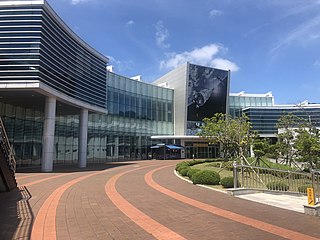
The Naro Space Center is a South Korean spaceport in South Jeolla's Goheung County, operated by the state-run Korea Aerospace Research Institute.

The K9 Thunder is a South Korean 155 mm self-propelled howitzer designed and developed by the Agency for Defense Development and private corporations including Dongmyeong Heavy Industries, Kia Heavy Industry, Poongsan Corporation, and Samsung Aerospace Industries for the Republic of Korea Armed Forces, and is now manufactured by Hanwha Aerospace. K9 howitzers operate in groups with the K10 Ammunition Resupply Vehicle variant.

Science and technology in Canada consists of three distinct but closely related phenomena:

Like most other regions in the world, science and technology in Korea has experienced periods of intense growth as well as long periods of stagnation.

KOMPSAT-2, also known as Arirang-2, is a South Korean multipurpose Earth observation satellite. It was launched from Plesetsk Cosmodrome, Russia at 07:45:43 UTC on 28 July 2006. It began to transmit signals at 14:00 UTC the same day. Like the earlier KOMPSAT-1 satellite, it takes its name from the popular Korean folk song Arirang. Its launch was the culmination of a project begun in 1995.
The SGR-A1 is a type of autonomous sentry gun that was jointly developed by Samsung Techwin and Korea University to assist South Korean troops in the Korean Demilitarized Zone. It is widely considered as the first unit of its kind to have an integrated system that includes surveillance, tracking, firing, and voice recognition. While units of the SGR-A1 have been reportedly deployed, their number is unknown due to the project being "highly classified".

STSat-2A was a satellite launched by the Korea Aerospace Research Institute (KARI), the national space agency of South Korea, from the Naro Space Center in Goheung County, South Jeolla using the Naro-1 (KSLV-1) launch vehicle.
STSat-2B, or Science and Technology Satellite-2B, was a South Korean satellite which was lost in the failure of the second flight of the Naro-1 launch vehicle. It was to have been operated by the Korea Aerospace Research Institute (KARI), and was intended to demonstrate technology for future spacecraft. The satellite had a mass of 100 kg (220 lb), and was expected to operate for at least two years.
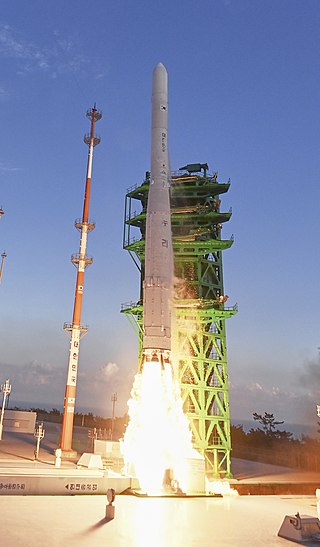
Nuri, also known as KSLV-II, is a three-stage launch vehicle, the second one developed by South Korea and the successor to Naro-1 (KSLV-1). Nuri is developed by Korea Aerospace Research Institute (KARI). All three stages use indigenously developed launch vehicle engines, making Nuri the first indigenously developed South Korean orbital launch vehicle.
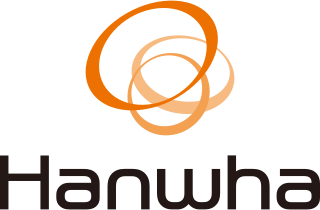
Hanwha Group is a large business conglomerate (chaebol) in South Korea. Founded in 1952 as Korea Explosives Co., the group has grown into a large multi-profile business conglomerate, with diversified holdings stretching from explosives—their original business—to energy, materials, aerospace, mechatronics, finance, retail, and lifestyle services. In 1992, the company adopted its abbreviation as its new name: "Hanwha".

STSat-2C, or Science and Technology Satellite-2C, or Naro Science Satellite (ko:나로과학위성) was a South Korean satellite which was launched in 2013. It was operated by the Korea Aerospace Research Institute (KARI), and was intended to demonstrate technology for future spacecraft. The satellite had a mass of 100 kg (220 lb), and was expected to operate for less than a year.
Seung Jo Kim is a South Korean aerospace engineer. He has been the current President of Korea Aerospace Research Institute (KARI) since June 2011, where the most of the national aerospace systems like aircraft, satellites and rockets are developed. During his tenure, Kim led the development of smart Unmanned aerial vehicle (UAV), the launch of KOMPSAT-3, KOMPSAT-5, STSat-3 and the first Korean space launch vehicle, Naro-1. Before becoming president of KARI, Kim had been a professor of the Engineering College at Seoul National University since 1986. He chaired the KSAS in 2009, the KSCM from 2005 to 2006, and the KSIAM from 2004 to 2008. He was also head of the New Aerospace Technology Research Institute from 2001 to 2003. Kim has been a fellow of the American Institute of Aeronautics and Astronautics (AIAA) since 2010 and the Institute of Physics since 2004.
Hanson Robotics Limited is a Hong Kong-based engineering and robotics company founded by David Hanson, known for its development of human-like robots with artificial intelligence (AI) for consumer, entertainment, service, healthcare, and research applications. The robots include Albert HUBO, the first walking robot with human-like expressions; BINA48, an interactive humanoid robot bust; and Sophia, the world's first robot citizen. The company has 45 employees.
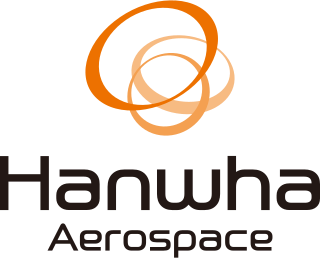
Hanwha Aerospace, formerly Hanwha Techwin Co Ltd, is a subsidiary of Hanwha Group, is an aerospace industrial company headquartered in Changwon, South Korea. It was established in 1977 as Samsung Precision. The company is Korea's only gas turbine engine manufacturer, and specializes in the development, production and maintenance of aircraft engines. In 1979, it started the aircraft engine business with gas turbine engine depot maintenance business, providing various gas turbine solutions to Korea and all over the world and by 2016 the company had produced more than 8,000 pieces of equipment.
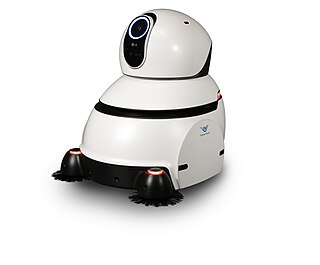
South Korea is one of the leading countries in the use of industrial robots worldwide, with the International Federation of Robotics listing it as having the world's second most automated manufacturing industry in 2019. The country's robot industry has grown from ₩6.29 trillion in 2016 to ₩9.18 trillion in 2020.





















